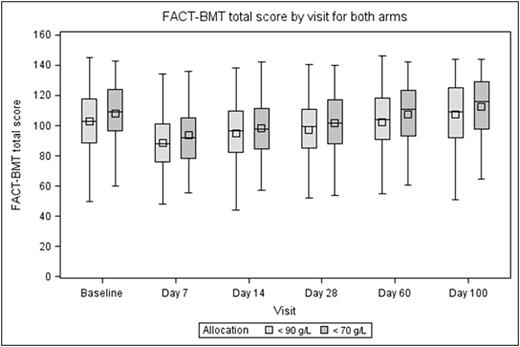Abstract

Background
Evidence regarding red blood cell (RBC) transfusion practices in Hematopoietic Stem Cell Transplantation (HSCT) is lacking. As a result, the impact of RBC transfusions on outcomes following HSCT is not well understood. We designed a non-inferiority Randomized Controlled Trial evaluating a restrictive and liberal RBC transfusion strategy with a primary endpoint of Health Related Quality of Life (HRQOL) as measured by the FACT-BMT scale at Day 100.
Methods
Patients with a hematologic malignancy requiring HSCT were randomized to either a restrictive (Hemoglobin (Hgb) threshold <70g/L) or liberal (Hgb threshold <90g/L) RBC transfusion strategies between Day-0 and Day-100). Permutated randomization blocks of 2 and 4 were used. Patients were stratified by centre and by type of HSCT. The non-inferiority margin selected for the study corresponds to a 12% absolute difference between groups in FACT-BMT score relative to baseline. Patients received a RBC transfusion if the Hgb was below the assigned threshold with the assessment of hemoglobin according to institutional practice (most often on a daily basis) with 2 units of RBC prescribed at the assigned threshold. The following endpoints were collected: 1) HRQOL by FACT-BMT, FACT-Anemia and EQ-5D at Baseline, Day 7, 14, 28, 60 and 100, 2) Transplant related mortality, Length of Hospital Stay, ICU admissions, Incidence and grade of acute graft versus host disease, Incidence of Serious infections, Transfusion requirements, Bleeding as per WHO Bleeding Scale, Incidence of adverse transfusion reactions, Bearman Toxicity Score and Sinusoidal Obstruction Syndrome. The primary endpoint was compared using a generalized linear model while accounting for any baseline differences in scores.
Results
We enrolled 300 patients (150 allogeneic and 150 autologous) undergoing HSCT between 28 Mar 2011 and 3 Feb 2016 at 4 Canadian adult HSCT centres. The difference in the overall mean pre-transfusion hemoglobin per patient over the study period between the groups was 13.7(±9.8) g/L. Statistical non-inferiority was detected between the liberal and the restrictive strategy as measured by the FACT-BMT at 100 days post-HSCT (Estimated difference in ratios between groups, -1.64%; 95% confidence interval, -0.07 to 0.04; P=0.0001 for non-inferiority) or any other time points (Days 7, 14, 28 and 60). In fact, the FACT BMT scores at all time points were higher for patients in the restrictive transfusion group. The median (IQR) number of RBC units transfused was lower in the restrictive-strategy group than in the liberal-strategy group [2(2-6) vs. 4(2-6), p=0.10], but this did not reach statistical significance. There were no statistical differences in any of the outcomes between the 2 groups.
Conclusions
The results of our study support the use of a restrictive RBC transfusion strategy as compared with a liberal strategy in patients undergoing HSCT as the HRQOL are similar and there are no appreciable differences in HSCT associated clinical outcomes.
Xenocostas:Janssen Inc.: Research Funding.
Author notes
Asterisk with author names denotes non-ASH members.

This icon denotes a clinically relevant abstract


This feature is available to Subscribers Only
Sign In or Create an Account Close Modal